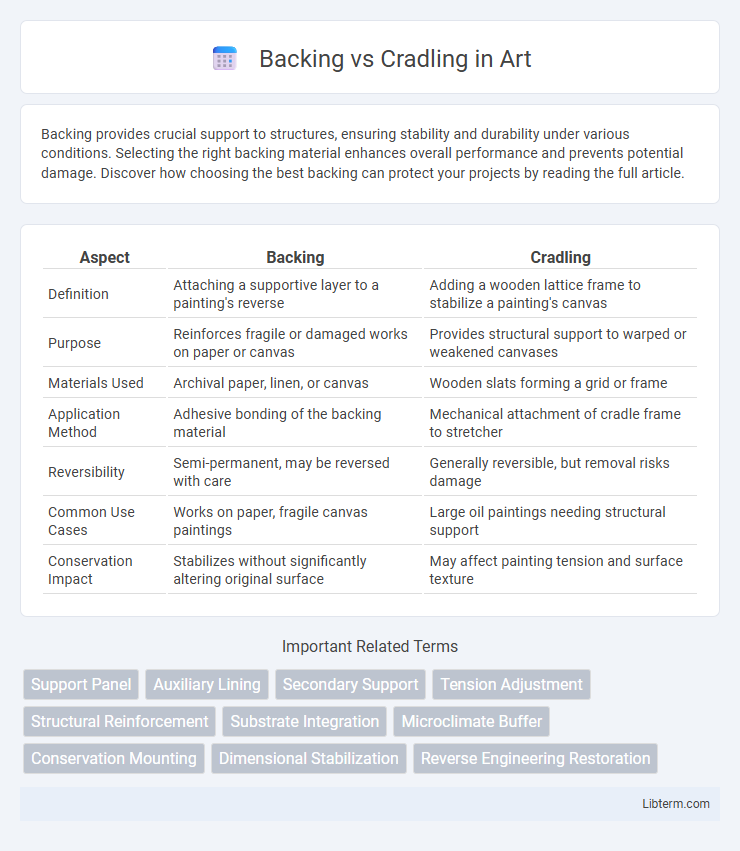Backing provides crucial support to structures, ensuring stability and durability under various conditions. Selecting the right backing material enhances overall performance and prevents potential damage. Discover how choosing the best backing can protect your projects by reading the full article.
Table of Comparison
| Aspect | Backing | Cradling |
|---|---|---|
| Definition | Attaching a supportive layer to a painting's reverse | Adding a wooden lattice frame to stabilize a painting's canvas |
| Purpose | Reinforces fragile or damaged works on paper or canvas | Provides structural support to warped or weakened canvases |
| Materials Used | Archival paper, linen, or canvas | Wooden slats forming a grid or frame |
| Application Method | Adhesive bonding of the backing material | Mechanical attachment of cradle frame to stretcher |
| Reversibility | Semi-permanent, may be reversed with care | Generally reversible, but removal risks damage |
| Common Use Cases | Works on paper, fragile canvas paintings | Large oil paintings needing structural support |
| Conservation Impact | Stabilizes without significantly altering original surface | May affect painting tension and surface texture |
Understanding Backing and Cradling: Key Differences
Backing involves supporting an object from behind for stability or reinforcement, commonly used in photography to enhance focus or in construction for structural integrity. Cradling refers to gently holding or supporting an object in a curved shape, often applied in art restoration to prevent warping in wooden panels or sculptures. Key differences lie in backing providing rigid support while cradling offers flexible, protective containment tailored to delicate forms.
The Purpose of Backing in Art and Conservation
The purpose of backing in art and conservation is to provide structural support and stability to fragile or damaged artworks, preventing further deterioration. Backing materials, such as archival paper or fabric, reinforce the artwork's surface while maintaining its original integrity and flexibility. This technique ensures longevity by protecting against physical stress, environmental factors, and handling damage.
Cradling Explained: Functions and Applications
Cradling in woodworking involves attaching a flexible lattice framework to the back of panel paintings, providing structural support and preventing warping or cracking over time. This technique is vital for preserving delicate artworks by distributing stress evenly across the surface and allowing controlled expansion or contraction due to environmental changes. Cradling is commonly applied in art conservation to stabilize aging paintings on wood panels, ensuring their longevity and maintaining aesthetic integrity.
Historical Context: Evolution of Backing and Cradling
Backing and cradling have evolved from early conservation techniques used to stabilize fragile artworks and manuscripts, with backing involving attaching a supporting material to reinforce weakened paper and cradling designed to support panel paintings by distributing stress across wooden frames. Early practices in the 19th century relied on heavy materials that often caused damage, leading to modern refined methods using reversible and less invasive materials that respect the artwork's integrity. This evolution reflects advances in conservation science and a growing emphasis on preserving original materials while ensuring structural stability.
Materials Commonly Used for Backing
Materials commonly used for backing include foam, felt, and rubber, which provide durability and stability to the overall structure. Foam backing offers lightweight cushioning ideal for upholstery and carpeting, while felt backing ensures sound absorption and added softness in textiles. Rubber backing is valued for its non-slip properties and resistance to moisture, commonly applied in mats and industrial fabrics.
Techniques and Tools for Effective Cradling
Effective cradling techniques involve gently embedding fragile artwork between layers of acid-free tissue or Japanese paper using reversible adhesives to stabilize and protect surfaces without causing damage. Tools such as silicone spatulas, micro-spatulas, and conservation-grade brushes help apply these adhesives precisely, ensuring even pressure and avoiding air bubbles or wrinkles. The process requires controlled humidity and temperature conditions, often assisted by blotting papers and weights, to facilitate proper adhesion and long-term structural support.
Benefits and Drawbacks of Backing
Backing provides increased structural support and stability, ideal for applications requiring durability under heavy loads, but it can add significant weight to the overall construction. The benefits include enhanced resistance to bending and improved load distribution, which extend the lifespan of supported materials. However, drawbacks involve reduced flexibility and potential difficulty in installation due to added thickness or rigidity.
Advantages and Risks Associated with Cradling
Cradling provides enhanced stability and control during spinal manipulations, reducing the risk of patient discomfort and injury by supporting the head and neck securely. Its advantage lies in minimizing strain on the practitioner's hands while maintaining precise alignment for effective treatment outcomes. However, improper technique in cradling can increase the risk of nerve impingement or excessive pressure on cervical vertebrae, potentially leading to complications such as muscle spasms or restricted blood flow.
When to Choose Backing Over Cradling
Backing is preferred over cradling when structural reinforcement is critical, such as in preventing brittleness or supporting fragile surfaces during conservation. This method stabilizes items with flaking paint or delicate textures by providing a firm, supportive layer. Choose backing in archival preservation to extend the lifespan of valuable artworks or documents requiring strong, non-invasive support.
Expert Recommendations on Art Preservation Methods
Experts in art preservation emphasize that backing provides structural support by reinforcing the artwork from behind, preventing warping and physical damage, while cradling involves attaching a wooden grid to the back of panel paintings to counteract warping and splitting. Conservation specialists recommend backing for canvas artworks as it enhances durability without compromising flexibility, whereas cradling is suited for wooden panels but requires careful monitoring due to potential long-term stress and movement. Proper selection between backing and cradling depends on the artwork's material, age, and condition, with ongoing expert assessment essential for preserving integrity and longevity.
Backing Infographic

 libterm.com
libterm.com